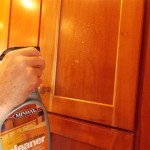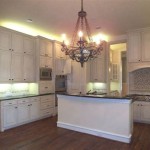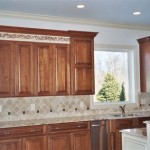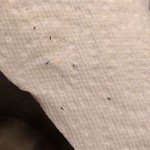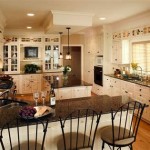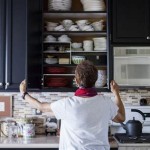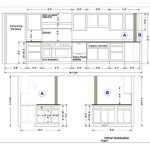How To Cover Laminate Kitchen Cabinets
Laminate kitchen cabinets, while durable and affordable, can sometimes look dated or clash with evolving design preferences. Fortunately, several methods exist to update their appearance without requiring a full replacement, offering cost-effective solutions for kitchen renovations.
Painting
Painting provides a dramatic transformation, allowing for complete color customization. However, proper preparation is crucial for successful adhesion and a smooth finish. The process typically involves thorough cleaning, sanding to create a textured surface, applying a specialized bonding primer, and then applying multiple coats of durable cabinet paint. Selecting a high-quality paint specifically designed for kitchen cabinets is recommended for increased longevity and resistance to moisture and wear.
Refacing
Refacing involves applying a thin veneer over the existing laminate surface. This veneer can mimic the appearance of real wood or offer a contemporary aesthetic with materials like vinyl. Refacing offers several advantages: it’s less time-consuming than replacing cabinets, produces less waste, and provides a durable, updated look. Professional installation is often recommended for achieving a seamless finish and ensuring precise measurements for doors and drawer fronts. The process updates the cabinet fronts while leaving the existing cabinet boxes intact.
Contact Paper
Contact paper offers a budget-friendly and relatively simple way to cover laminate cabinets. Available in a wide array of colors, patterns, and textures, including wood grain and metallic finishes, contact paper can quickly refresh a kitchen's aesthetic. Application involves meticulous measuring, cutting, and smoothing the adhesive-backed paper onto the cabinet surfaces. While less durable than painting or refacing, contact paper provides a temporary solution for renters or homeowners seeking a quick, low-cost update. Careful application can minimize air bubbles and ensure a smooth, professional appearance.
Cabinet Wraps
Cabinet wraps, similar to contact paper, offer a peel-and-stick application method. However, cabinet wraps are typically thicker and more durable than contact paper, providing better resistance to scratches and wear. They come in a variety of finishes, including matte, gloss, and textured options, offering a range of design possibilities. This method allows for a quick and relatively easy transformation without the need for specialized tools or extensive surface preparation. Cabinet wraps often feature air-release technology, simplifying installation and minimizing the risk of air bubbles.
New Hardware
Replacing existing cabinet hardware can significantly impact the overall appearance of laminate cabinets. Swapping dated knobs and pulls for more contemporary styles can instantly modernize the kitchen. Choosing hardware that complements the existing or planned color scheme and design aesthetic is crucial for a cohesive look. Consider materials such as brushed nickel, stainless steel, or black matte for a modern touch, or opt for ornate designs for a more traditional feel. This relatively inexpensive change can make a significant difference in the overall perception of the kitchen.
Molding and Trim
Adding decorative molding and trim can elevate the appearance of laminate cabinets, giving them a more custom and built-in look. Molding can be applied to the top, bottom, or sides of cabinets, creating visual interest and architectural detail. Choosing molding profiles that complement the kitchen's overall design style is essential for a cohesive and polished result. This method can effectively conceal the seams of the laminate and enhance the perceived quality of the cabinets.
Decorative Inserts
Glass inserts or decorative panels offer another avenue for updating laminate cabinet doors. Replacing solid cabinet door panels with glass inserts can create a lighter, brighter feel in the kitchen. Frosted or textured glass offers privacy while still allowing light to pass through. Alternatively, decorative panels with intricate patterns or textures can add a unique touch and elevate the cabinet's aesthetic. This customization option allows homeowners to personalize their kitchens and create a focal point in the space.
Chalkboard Paint
Applying chalkboard paint to sections of laminate cabinets, particularly pantry doors or cabinet sides, offers a functional and stylish update. Chalkboard paint creates a writable surface for grocery lists, recipes, or family messages. This adds a touch of personality and practicality to the kitchen, particularly in family homes. Chalkboard paint is available in various colors, allowing for customization and coordination with existing décor. It provides a durable, washable surface suitable for frequent use.
Beadboard Wallpaper
Beadboard wallpaper can provide a cottage-chic or farmhouse aesthetic to laminate cabinets. This textured wallpaper mimics the look of traditional beadboard paneling without the expense and labor of installing actual wood. It’s readily available and relatively easy to apply, providing a cost-effective way to add texture and visual interest to plain laminate surfaces. Beadboard wallpaper often comes in pre-pasted or peel-and-stick versions, simplifying the application process.

How To Paint Laminate Kitchen Cabinets Perfect Finish Tips

How To Paint Laminate Cabinets The Interiors Addict

How To Add Trim And Paint Your Laminate Cabinets

Painting Laminate Cupboards Crowies Paints

Painted Laminate Cupboards Kitchen Painting Cabinets

How To Paint Laminate Cabinets Everything You Need Know

A Year In Review Of How I Painted My Laminate Cabinets With Two Methods

How To Paint Laminate Kitchen Cabinets Eatwell101

Painting Kitchen Cabinets Without Primer

How To Paint Laminate Kitchen Cabinets Perfect Finish Tips
Related Posts

